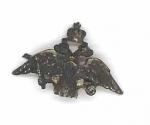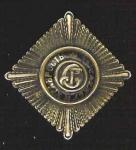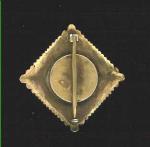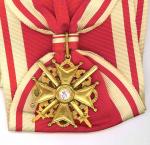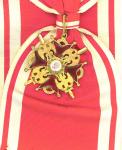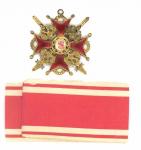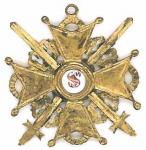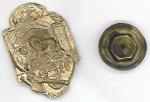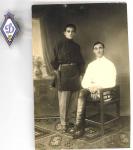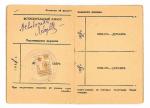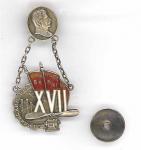-
Posts
1,582 -
Joined
-
Last visited
-
Days Won
1
Content Type
Profiles
Forums
Blogs
Gallery
Events
Store
Everything posted by Chuck In Oregon
-
<<He was a Leitenant-- perhaps of aviation branch?>> Here is an aviation shoulder board insignia for closer comparison. Chuck
-
That's about all you could ask for in a late Imperial photo. Very nice, detailed and clear. I have some and I'll post a few, but yours is about as good as it gets. I also have two small WW I photo albums, one from the CO of a mule-drawn pack howitzer unit and the other from the CO of a heavy machine gun unit. Both are from the Turkish front. I'm not yet sure how to go about copying and posting them without damaging them. I'll give that some thought. I know that I would have bought your photo in a heartbeat if I had come across it. Chuck
-

Imperial Russia Post yourImperial russian orders and badges
Chuck In Oregon replied to GeorgeCL's topic in Russia: Imperial
Moderators and Gentlemen Is there any possibility of a dedicated Imperial Russia forum? What would it take? Don't these things deserve more than one posting in a continuing thread? That certainly doesn't create a good research and comparison opportunity for any award or topic. I promise to contribute at least ten new threads within the first week to open things up if GMIC decides to create one. Anyone else? I realize that Imperial isn't the current rage, but it is darn interesting and varied and it offers a lot of collecting opportunities for less than, say, the latest prices for equivalent Soviet or Third Reich awards. The market seems wide open to me, but what do I know? Still, inquiring minds want to know. Chuck -

Imperial Russia Post yourImperial russian orders and badges
Chuck In Oregon replied to GeorgeCL's topic in Russia: Imperial
OK, one more tonight. I'll likely never have an Order of St. George breast badge, but I do have this frachnik, or miniature, of one for wearing on other than a uniform. This one is both proofed and hallmarked. The letters may once have been gilted but they don't show any remaining traces under my 10x glass, only the silver beneath. In contrast, the two circles have perfect gilt, enough so that I wonder if they are really solid gold. The pin on the reverse is still tight and functional, although I don't tempt fate by playing with it. -

Imperial Russia Post yourImperial russian orders and badges
Chuck In Oregon replied to GeorgeCL's topic in Russia: Imperial
-

Imperial Russia Post yourImperial russian orders and badges
Chuck In Oregon replied to GeorgeCL's topic in Russia: Imperial
Here's a Transition Government St. Stan-2. No crowns on these, the better to maintain the fiction that really, not that much was going to change, I guess. Military version, of course, with swords. Note the major differences in the style of leaves on the obverse, comparing this to the previous one. This is a very nice example of this variation, IMHO. The large ribbon is wrong. You probably know that. It is the ribbon for a first class. The family I bought this one from insisted that the recipient also had a first class but they had sold it. Who knows? Anyway, they did have this ribbon. Later on, they called and said they had the second class ribbon, if I wanted it. That's the one you see in the previous post. -

Imperial Russia Post yourImperial russian orders and badges
Chuck In Oregon replied to GeorgeCL's topic in Russia: Imperial
Now THAT'S what I'm talkin' about! OK, here's a late pre-Transition Government St. Stan-2nd, military only of course by then, with swords. Gilt over bronze, I think. That's the correct smaller ribbon, but it came out of another set. -

Imperial Russia Post yourImperial russian orders and badges
Chuck In Oregon replied to GeorgeCL's topic in Russia: Imperial
Good afternoon I am pretty new to GMIC and this is my first time in this forum. I have already posted a few Soviet badges in that forum. I have collected a lot of Imperial Russian items over the past several years and I was hoping to find an active interest in that topic. To the best of my knowledge, there isn't an active forum devoted to Imperial Russian militaria and collectibles anywhere. Too bad. That's something I would enjoy seeing, participating in and learning more about. Regardless, I'll start my contributions off here with a couple of Orders of St. Anna, 4th and 3rd classes, military versions with swords, late-era gilt over ... over what? For the swords and filigree, probably brass, maybe bronze. For the metal of the crosses themselves, both crosses are hallmarked and the metal underneath the red enamel is grey, as you can see. I suppose it could be silver but I just don't know. These aren't pristine, of course, but they're good enough for me. If the interest is here and others will post a few things, I'll be glad to contribute my own modest collectibles for your enjoyment. georgecl, #84503 is about as nice a late St. George Cross-3rd as anyone will ever see. Good find. Kindest regards, Chuck -
I like this early little badge a lot, but I don't have a clue as to what it really is. If you do, please share your knowledge. Check out the details closely. There is a band saw on the right and a prominent axe (really an adze, I think, for shaping wood rather than, say, tree falling or trimming). There is also what looks like a lever with a round end just to the right of the adze head, signifying who knows what. The guy on the badge is using what appears to be a heavy, old-style all-wood plane to shape a beam. He is wearing what I would call a shop apron over a long-sleeved shirt with rolled-up sleeves. He is also wearing something (goggles, dust mask, I can't really tell) that he has pushed up above his forehead. The shavings coming off of the planed beam seem to make four stylized letters. Unfortunately, I can't make out what the letters are, so I don't have a clue what they might stand for. They look more like Latin letters than Cyrillic. Behind the adze, saw and letters is a large round saw blade, like the kind found in saw mills, and there is a two-man saw, probably for cutting boards rather than, again, for falling timber. You can see the round saw blade's teeth at the bottom and above, behind the letters, and the individual teeth on the two-man saw. Just as an aside, you can still see men in the third world making lumber out of logs with two-man saws like the one on the lower left edge. One guy, obviously the junior partner, stands down in a trench and the log is placed lengthwise on top of the trench. The second guy, on top, helps to position the saw and start the cut and then they start two-man push-pull sawing down the log, with the sawdust, dirt and sweat falling all over the lower guy in the trench. Interestingly enough, they can cut some pretty decent lumber that way, certainly good enough to plane to size. But I digress. The nut is cheap but kind of unusual and may not be original. The insignia at the top is common enough, as is the red enamel with the rays underneath. The metal seems to be plated bronze or brass. Now check out the big building. Each of the windows contains a separate spot of blue enamel. I was amazed when I realized that. With the smoking chimneys it must be a factory of some sort, maybe related to lumber production or something like that. And did you notice that the details of the head of the band saw are made with four squares of black enamel? And what about the rectangular compartmentalized whatever-it-is on the left, as we look at the badge. What the heck is that? It looks to me like something in a building in large stacks and there appears to be black enamel between the stacks. My guess is ... a wood drying kiln. Your guess will be equally valid and likely more so. OK, enough of my droning about one old badge, but this is one of the busiest and most interesting small badges I have ever seen. I can't imagine going to all that trouble just to make one small badge. It's just that this one has always intrigued me and I wanted to share it. Enjoy. Chuck
-
Thanks, Jan. I thought they were veterans' badges, not official medals. However, these particular ones have a very notable provenance, so that's something I should have imagined. Chuck
-
-
* * * * * Although Soviet state security is a fascinating field, I am by no means knowledgeable regarding it. As I understand it, the Imperial MVD died a violent death during and right after the revolution. It, and the Okhrana, were replaced by the Cheka-GPU. If I'm not mistaken -- and I welcome correction -- the modern MVD was reconstituted out of the NKVD in 1946 when Narkomats gave way to Ministries. So, a Chekist-GPU award, but not MVD ... I think. Just my two cents, and worth every penny. Chuck
-
... And here is a studio portrait of Comrade Kipiani, standing and armed with what appears to be a Luger. I believe the Broomhandle Mauser was the standard-issue Cheka weapon of the day, when they were available. Perhaps officers were allowed to, or had to, provide their own sidearm. I love period photos, especially attributed ones. Note that while neither wears a medal, badge or other device, each is displaying a wristwatch, worn over his shirt sleeve. I have seen that before. Watches must have been signs of status -- not to mention useful tools if you are a state security officer -- and you couldn't hide status under a sleeve, could you? Of course, status in the Cheka could and would get many officers murdered. The 10-Year Jubilee Badge of Club Dynamo also came with this small group. Lord knows, there are a lot of Club Dynamo badges, probably hundreds of them over the years. However, this is the only example of this early variant that I have come across. It is silver, in three parts, two rivets, three colors of enamel and the X appears to be solid gold. It has an MMD hallmark. Regards to all, Chuck
-
I have been quite fortunate in finding some early Chekist items in my travels. I believe that this badge is uncatalogued and unknown in the west. I hope that the number on the reverse, "N 41", is visible in the photo. On its face, this is the 1932 10-Year Jubilee Badge of the Trans-Caucasus Cheka-GPU. Likely very, very few survive today. The document, dated Oct. 30, 1932, refers to it as an Excellence Badge for 10 Years of the ChK-GPU ZCFSR, awarded to Comrade Ilia Georgievich Kipiani, chief of the Trans-Caucasus Region Border Guard Special Service. (NB: I welcome better translations than my own, so feel free.) It is specifically numbered to the badge, N 41. Kipiani is a fairly common Georgian name, typically from the Migrelian region that also gave us L. Beria. They could hardly not have been acquainted. Although numbered, the badge has no hallmark. That is not unusual. Early badges from the Soviet Trans-Caucasus Region and Soviet Georgia were often commissioned and made in Tbilisi. Tbilisi has been an art and jewelry center for centuries. Photo and reverse to follow. Chuck
-

Soviet Roadbuilder Badges
Chuck In Oregon replied to Chuck In Oregon's topic in Russia: Soviet Orders, Medals & Decorations
* * * * * OK, my first laugh of the day. Thank you. I've got a LOT of documents, including some early Chekist documents, even complete pre-war major criminal files. They're hard to do justice to, and they'll take some time, but I'll see what I can do. Chuck -

Soviet Roadbuilder Badges
Chuck In Oregon replied to Chuck In Oregon's topic in Russia: Soviet Orders, Medals & Decorations
* * * * * Hi Dave It's nice to see some familiar faces on this forum. If you haven't seen those documents, then they must be unusual. I know it's the only one I've ever seen. Does anyone else have any of these Otlichnik documents? If you do, I'd like to see them. Speaking of documents, are they welcome and of interest on this forum? I mean, documents without accompanying hardware or that never had accompanying hardware. Chuck -
Tourism is one thing that I seldom associate with the USSR. And as for tourism during the depths of the Depression? One could even speculate that people who could afford to travele for pleasure, on their own kopek, might even be guilty of the crime of unearned income. That crime was good for 15 years in the gulags and could get the offender a 9mm salute. But noooo! (Thank you, John Belushi.) Here is a badge for the "All-Soviet Benevolent Society for Proletarian Tourism and Travel" and its accompanying 1931 booklet. My Russian leaves much to be desired, so please feel free to correct my translations. The booklet is very cheap plain brown cardboard, simply printed and folded over with four double pages stapled inside. The membership is signed off and the stamp signifies that the 30-kopek dues for 1931 were paid. As I recall, dues stamps for later organizations were not always organization-specific. In this case, however, the badge, the stamp on the cover of the booklet and the dues stamp all match. There does not appear to be a design in the star on the cover. On the inside back cover there is the six-step code of the honored tourist. As I roughly translate the final sentence, it says "Promote (lit. assist) the Communist Party and the culture of the Revolution and socialist workers." An old friend thinks he might want this one, so I thought I would post it while I still have it. Enjoy. Chuck
-
Here's a badge you don't often see. It is for a delegate to the 17th Conference of the Communist Party in 1934. The reason you don't see them? Most of delegates were murdered during The Terror. In fact, I suspect that they were the prime early targets of The Terror just because they might have been tainted with the brush of Menshevik "rotten liberalism" while attending the conference. Stalin was there, too, of course. He conveniently exempted himself from suspicion. According to David King in The Commissar Vanishes, "There had been 1,961 delegates at this congress. No fewer than 1,108 of them were liquidated." How did they get anyone to attend the 18th? Chuck
-

Soviet Roadbuilder Badges
Chuck In Oregon replied to Chuck In Oregon's topic in Russia: Soviet Orders, Medals & Decorations
-

Soviet Roadbuilder Badges
Chuck In Oregon replied to Chuck In Oregon's topic in Russia: Soviet Orders, Medals & Decorations
I completely forgot that I have another example of the Georgian variant, and this one comes with the document. Chuck





